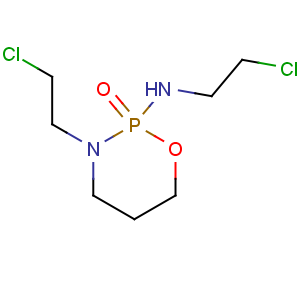Title: Ifosfamide
CAS Registry Number: 3778-73-2
CAS Name: N,3-Bis(2-chloroethyl)tetrahydro-2
H-1,3,2-oxazaphosphorin-2-amine 2-oxide
Synonyms: 3-(2-chloroethyl)-2-[(2-chloroethyl)amino]tetrahydro-2
H-1,3,2-oxazaphosphorin-2-oxide; iphosphamid(e); isoendoxan; isophosphamide
Manufacturers' Codes: A-4942; Asta Z-4942; MJF-9325; NSC-109724; Z-4942
Trademarks: Holoxan (Baxter); Ifex (BMS); Ifomide (Shionogi); Mitoxana (Baxter)
Molecular Formula: C7H15Cl2N2O2P
Molecular Weight: 261.09
Percent Composition: C 32.20%, H 5.79%, Cl 27.16%, N 10.73%, O 12.26%, P 11.86%
Literature References: Cytostatic agent, related structurally to cyclophosphamide,
q.v. Prepn:
FR 1530962 (1968 to Asta),
C.A. 71, 49998m (1969); H. Arnold
et al., US 3732340 (1973 to Asta). Chemical properties: H. Arnold,
Proc. 5th Int. Congr. Chemother. Vienna (Verhandlungen, Vienna, 1967)
2, pp 751-754. Pharmacology: N. Brock,
ibid. pp 155-161. Molecular structure and conformation: H. A. Brassfield
et al., J. Am. Chem. Soc. 97, 4143 (1975). Mass spectrometry: M. Przybylski
et al., Biomed. Mass Spectrom. 4, 209 (1977). Mechanism of action: S. Tomita
et al., Chemotherapy (Tokyo) 25, 3014 (1977). Metabolism: A. Takamizawa
et al., Chem. Pharm. Bull. 25, 2900 (1977);
eidem, J. Med. Chem. 17, 1237 (1974). Toxicity studies: R. Marcy
et al., IRCS Med. Sci. Libr. Compend. 5, 427, 478 (1977). Mutagenicity studies: D. Wald,
J. Mutat. Res. 56, 319 (1978); G. R. Mohn, J. Ellenberger,
ibid. 32, 331 (1976). Clinical studies: P. J. Creaven
et al., Cancer Treat. Rep. 60, 445, 451 (1976); J. Schnitker
et al., Arzneim.-Forsch. 26, 1793 (1976). Symposium on clinical efficacy and comparison with cyclophosphamide:
Cancer Chemother. Pharmacol. 18, Suppl. 2, S1-S58 (1986). Reviews of pharmacology, toxic effects and clinical activity: M. Zalupski, L. H. Baker,
J. Natl. Cancer Inst. 80, 556-566 (1988); S. E. Schoenike, W. J. Dana,
Clin. Pharm. 9, 179-191 (1990).
Properties: Crystals from anhyd ether, mp 39-41°. LD50 in rats (mg/kg): 160 i.p. (Arnold, 1973); also reported as 150 i.p. (Brock).
Melting point: mp 39-41°
Toxicity data: LD50 in rats (mg/kg): 160 i.p. (Arnold, 1973); also reported as 150 i.p. (Brock)
Therap-Cat: Antineoplastic.
Keywords: Antineoplastic; Alkylating Agents; Nitrogen Mustards.

